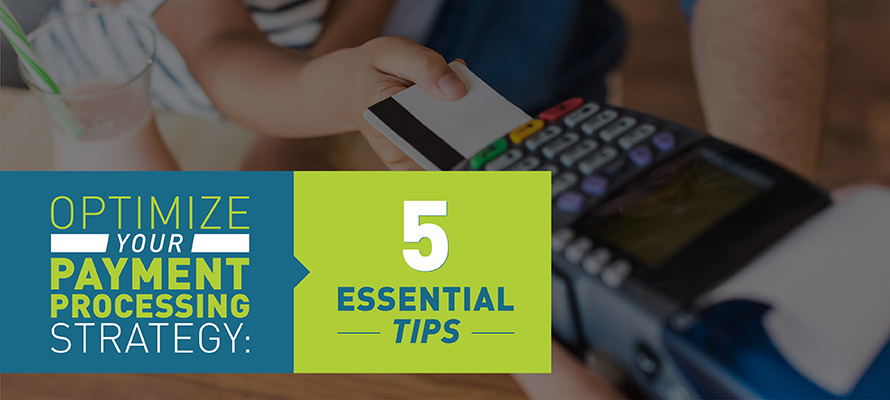For businesses large and small, your payment processing strategy is one of the central elements of achieving profitability, longevity, and overall success.
All too often, businesses struggle to meet their goals each month due to an ineffective payment processing system or an unclear understanding of how payment processing and consumer security should actually work.
When these issues compound, that can spell disaster for your bottom line and dash all hopes of growing your business in the long term.
Is your team curious to find out what it takes to optimize how you approach payment processing? Luckily, getting your payment processing strategy right isn’t as hard as it used to be.
Check out some of these smart payment processing best practices your business should take advantage of:
- Get familiar with payment processing systems.
- Know the different methods of credit card fraud.
- Learn strategies to prevent fraudulent charges.
- Choose an effective payment processing system.
- Accept a variety of payment methods.
Whether your business is a small, locally-owned pizza shop or a large, multinational corporation, getting your payment processing strategy in line should be your first priority.
Ready to take control of how your business processes payments? Let’s jump into these effective tips!
1. Get familiar with payment processing systems.
By far, the best way to improve how you manage your payment processing strategy is to get back to the basics. This means your team should sit down and review what kind of payment processing solutions are out there and how they can work for your needs.
There are two main styles of payment processing systems. These are payment aggregators and dedicated payment processors. They differ in a few key ways:
- Payment aggregators are large businesses that handle the portfolios of many companies. They process transactions through a common interface, like an app, widget, or website. Companies like PayPal, Stripe, and Square are all aggregators, and they share communal merchant accounts with their clients to process payments.
- Dedicated payment processors are more closely configured to the needs of their individual clients. Instead of sharing a large merchant account between many different businesses, dedicated payment processors will allow your business to use its own merchant account to process transactions.
If your business already has a payment processing system in place, which kind do you use? Are you happy with your experience thus far?
Both forms of payment processors present benefits and drawbacks to businesses. Since payment aggregators manage a much larger number of portfolios, some businesses opt to partner with a dedicated payment processor to receive more tailored attention.
However, this kind of attention comes at a cost. Dedicated payment processors typically require a larger investment on the part of a business and may not be the right choice for younger companies with tighter budgets.
When it comes to payment aggregators, these services stand out by offering customers a more familiar, streamlined user experience. Consumers often encounter aggregators like PayPal, Stripe, or Square when making transactions at other businesses, so your team can tap into that familiarity to foster trust between your company and its customer base.
Bonus! Think a payment aggregator might be the right choice for your business, but you’re not sure if PayPal is the best option out there? Check out Double the Donation’s PayPal alternatives breakdown for a look at some strong competitors you might not know about yet.

1-Click Login is a simple & secure password-free authentication service.
With our patented technology, your website can improve security & increase customer conversion by removing passwords.
2. Know the different methods of credit card fraud.
Choosing the right payment processor for your business is highly dependent upon understanding the security needs of your company.
The bottom line? You’ll need to choose a trustworthy partner that offers a variety of fraud protection features. However, depending on your business model, certain fraud risks will be more prevalent than others.
Let’s go over some of the most common payment fraud schemes and how they can affect your business:
- Identity theft. This is the most common kind of payment fraud and encompasses most other fraud schemes. Your payment processor should have measures in place to detect identity theft as well as prevent the identities of your customers from being stolen.
- Credit card tumbling. With credit card tumbling, identity thieves randomly generate credit card numbers and use online transaction forms to test out the numbers. Your business could be at risk if random users attempt dozens or hundreds of small transactions.
- Refund fraud. In these schemes, fraudsters generally take a stolen credit card and make a purchase through a business like yours. Then, they’ll cancel the payment by making a call to their victim’s bank posing as them. They’ll collect the refund from their victim’s account, and your business could be hit with fees.
If your business wants to be seen as trustworthy by your clientele, you should take these core fraud schemes seriously. When your payment processing strategy is security-focused, you’ll be able to build long-lasting, dependable relationships with patrons.
3. Learn strategies to prevent fraudulent charges.
Now that we’ve reviewed the top payment fraud schemes, it’s important to take a closer look at the different ways payment processors address these issues for their clients.
You’ll want to choose a payment processor that offers a variety of fraud-prevention and protection measures without having to pay extra for must-have features.
Consider some of these common fraud prevention solutions your team should look for in your payment processing partner:
- Two factor authentication. This method allows your customers to verify their identities before completing a transaction by responding to a special email or SMS message.
- BIN/IP address verification. Using this strategy, your payment processor will automatically cross-reference the IP address of customers with the address tied to their credit card.
- Card verification codes. For online payments, requiring users input their three-digit credit card verification code (CVV) can block certain identity theft schemes.
- Minimum transaction limits. These can come in handy in preventing credit card tumbling from occuring on your company’s website.
- EMV chips. For on site payment processing, EMV chip readers can give customers peace of mind that their financial information is safe from hacking.
Bonus tip! Businesses with a physical presence, like restaurants, can benefit greatly from having EMV chip reading technology at their point-of-sale (POS) system. Learn more about point-of-sale best practices by visiting Lavu’s cyber security guide.
4. Choose an effective payment processing system.
Strengthening your payment processing strategy isn’t limited to security concerns, though. In finding the right payment processor for your business, you’ll need to keep a handful of core attributes in mind.
Your business’ payment processor system should be:
- Intuitive. Internally, your payment processing system should be intuitive to use for your staff members and require minimal training to master.
- Customizable. Choose a solution that gives your team the ultimate power over customizing how you process payments and engage with customers.
- Portable. Find a payment processor that gives your business the technology to transact from wherever your customers already are—on the web and in person.
Another important factor to consider when selecting your payment processor (or deciding whether to leave your current one) is how seamlessly the system integrates with your other software.
If you have to create a patchwork software ecosystem between your data reporting tools, employee management system, and payment processor, you’re bound to run into logistical confusion.
The whole point of rethinking your payment processing strategy is to smooth out the kinks of your behind-the-scenes operations, so be sure to choose a solution that integrates well with your existing software or offers their own solutions as part of a comprehensive software suite.
Say Goodbye to Passwords
and
Hello to Secure Logins.
Go passwordless and delight your users with secure and seamless one-click login.
5. Accept a variety of payment methods.
Over the past several years, the way that businesses accept payments from customers has evolved over leaps and bounds.
The fact of the matter is that if your team wants to find an adaptable payment processing solution that will stand the test of time, you need to choose a partner that already puts customer preference first when it comes to payment methods.
This way, your team can be sure right out of the gate that your payment processor takes the convenience of your clientele seriously. Look out for some of these essential payment methods that your payment processing partner should offer:
- Credit/debit. These are the baseline payment methods that your system should offer regardless of whether or not you conduct transactions primarily on site or online.
- EMV chips. Short for EuroPay, MasterCard, and Visa, these chips are now standard on new payment cards and require EMV chip reader technology to function.
- Contactless payment. This payment method uses near-field communication (NFC) to read payment cards without the customer swiping or “dipping” their card.
- Split checks. For restaurants and bars especially, having the ability to cleanly split checks among customers can be a crucial factor in boosting return patronage.
What’s one great way to ensure that your patrons return again and again to your business? Offer secure user accounts that keep their information on file for future transactions. This way, they won’t need to worry about re-entering personal payment information every time they want to make a transaction.
Taking charge of your payment processing strategy should be at the top of your list when finding ways to strengthen your business model.
With these optimization tips on hand, you’ll be ready to find the right payment processor for your needs and get started conducting smarter transactions!
Author Bio

Don Hsieh is Director of Marketing, responsible for developing and executing the go-to-market strategy for Lavu. He is passionate about gaining deep customer insights to deliver compelling value propositions that drive profitable growth. Don brings over 20 years of experience in the technology industry leading the development of multiple vertical markets and channels of distribution to accelerate growth at top-tier technology firms such as Hewlett-Packard, NCR, Konica Minolta and ADT. He also serves on the Board of Directors for Feeding South Florida; whose mission is to end hunger in South Florida.




